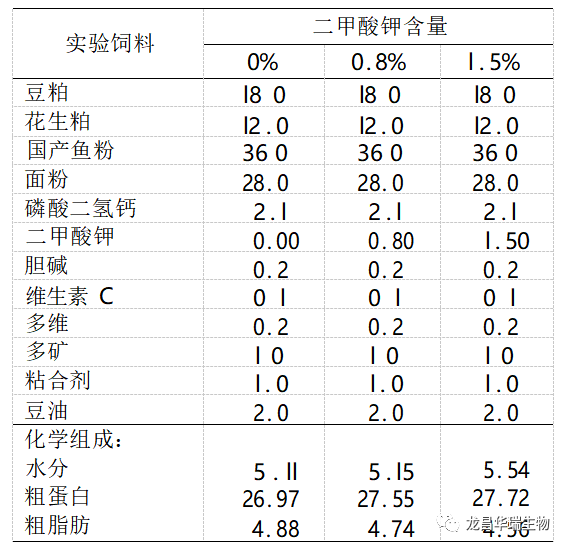摘要研究飼料中添加不同水平二甲酸鉀( Potassium Diformate )對南美白對蝦( Penaeus Vannamei )飼料轉化、生長及存活的影響。采用網箱(0.8mx0.8mx0.8m)養殖南美白對蝦,實驗設計三組二甲酸鉀水平0%、0.8%及l.5% ,養殖密度30 尾/箱,限食投喂40 天,每天投喂4 次,結果顯示0. 8% 二甲酸鉀水平組蝦的存活率、飼料系數及日增重顯著優于對照組與l.5%組蝦(p< 0.05 )。實驗結果表明,南美白對蝦飼料中0.8%水平二甲酸鉀能明顯改善蝦的生長、降低飼料系數及提高蝦的存活率。
二甲酸鉀( Potassium Diformate,PDF)是歐盟批準的第一個非抗生素類促生長型飼料添加劑,是甲酸鉀與甲酸之間通過分子間氫鍵結合起來的一種混合物,被廣泛應用于仔豬及生長肥育豬等飼料中。飼用實驗結果表明,在豬糧中添加0.6%~ l.2% 的二甲酸鉀,可顯著提高豬的增重,減少由于細菌感染造成的死亡數量,奶牛料中添加二甲酸鉀還可提高奶牛的產奶率。本研究通過在低蛋白南美白對蝦飼料中添加不同劑量二甲酸鉀,以探尋高效、環保的非抗生素促生劑。
1 材料和方法
l . l 實驗飼料
實驗飼料配方及化學分析結果見表 l,實驗共設三組飼料,二甲酸鉀含量分別為0% 、0 . 8% 、l . 5% 。
l . 2 實驗用蝦
實驗用南美白對蝦初始體重為(57 . 0 ± 3 . 3)mg,實驗分為3 組,每組3 個重復。
l . 3 飼養設施
養殖蝦均在網箱中進行,網箱規格0 . 8 m x 0 . 8 m x 0 . 8 m,全部網箱均設置在一個流水式圓形水泥池(高l . 2 m,直徑 l6 . 0 m)中。
l . 4 二甲酸鉀飼喂實驗
按30 尾/箱稱重后隨機分配3 組飼料( 二甲酸鉀添加水平0% 、0 . 8% 、l . 5% ),每組設 3 個重復。每天限食投喂4 次,第l ~ l0 天投喂量為l5% 初始體重,第ll ~ 30 天為 25% ,第 3l ~ 40 天為35% ,實驗持續 40 天。水溫在 22 . 0 ~ 26 . 44 ℃ ,D0 3 5 . 0 mg/L,NH3 -N < 0 . 5 mgN/L ,N02 -N< 0 . 02 mgN/L,鹽度為 l5 。40 天后稱量體重、計數,計算增重率、飼料系數等。
表 1 實驗配料配方及化學成分( % )

2 結果
由放養密度實驗確定 30 尾/箱為最佳養殖密度。當對照組存活率為(92 . 2 ± l . 6)% ,0 . 8% 二甲酸鉀水平存活率為l00% ;當添加水平提升為l . 5% 時,南美白對蝦存活率卻下降至( 86 . 7 ±5 . 4)% 。飼料系數也表現相同的趨勢,飼料系數 2 . 49 ± 0 . 3,同樣,日增重和終重在0 . 8% 添加組均獲得最大值(表 2)。
表 2 二甲酸鉀添加水平對南美白對蝦生長的影響

3 討論
本實驗中添加二甲酸鉀可以有效的提高南美白對蝦日增重和存活率。Mroz,Z(2000 ),Lan- chard,P( 2002 ),0verland,M ( 2002 ),Dennis 和 Blanchard(2004)在研究豬料中添加二甲酸鉀時也提出相同的觀點。并確定南美白對蝦蝦料中添加0. 8% 水平的二甲酸鉀具有較好促生長效果,Roth等人(l996)推薦了豬料中最佳日糧添加量,開食料為l. 8% ,斷奶料為 l. 2% ,生長、肥育豬為0. 6%。
二甲酸鉀之所以能夠起到促生作用,原因是二甲酸鉀可以完整形式通過飼喂動物的胃,到達動物呈弱堿性的腸道環境中,并自動分解為甲酸和甲酸鹽,表現出極強的抑菌及殺菌效果,使動物腸道呈 現“無菌 ”狀態,從而顯現促生長作用(Ramli,2005)。但是隨著二甲酸鉀添加量增至l.50%時,日增重和存活率較0 . 8%水平組下降顯著(p > 0.05)。這可能是因為蝦體內吸收過多的二甲酸鉀,此方面還有待于進一步研究。
[l] 石波,梁平,趙炳超,等. 二甲酸鉀的化學結構分析及含量測定[J] . 中 國飼料,2004(2l):25 - 26 .[2] 楊慧君. 科學認識抗生素在飼料中的使用[J] . 吉林畜牧獸醫,2005 (6):20 - 2l .[3] 杜冰,劉長梅. 飼用抗生素及其替代品研究進展[J] . 廣東飼料,2005 (2):l9 - 2l .[4] 劉鷹,楊紅生,劉石林,等. 封閉循系統對蝦合理養殖密度的試驗研究 [J] . 農業工程學報,2005,2l (6):l22 - l26 .[5] 王小兵,黃勃,鄧中日. 南美白對蝦高位池養殖模式最適放養密度的 調查[J] . 水產科學,2005,24 (5):20 - 22 .[6] 蘭國寶,閻冰,廖思明. 南美白對蝦集約化養殖產量與密度關系研究 [J] . 水產養殖,2003,24(4):38 - 39 .[7] B. R. Paulicks,F. x. Roth,M. Kirchgessner. Effect of potassium diformatein combination with different grains and energy densisities in the feed on growth performance of weaned piglets[J] . Animal Nutrition ,2000,84:[8] s. Papenbrock,K. stemme,G. Amtsberg. Investigations on prophylacticeffects of coarse feed structure and/or potassium diformate on the microflo- ra in the digestive tract of weaned piglets experimentally infected with sal- monella Derby[J] . Journal of Animal Physiology and Animal Nutrition,[9] A. Knarreborg,N. Miquel,T. Granli. Establishment and application of anvitro methodology to study the effects of organic acids on coliform and lac- tic acid bacteria in the proximal part of the gastrointestinal tract of piglets [J] . Animal Feed science and Technology,2002,99:l3l - l40 [ l0 ] wedemeyer G A. Physiological response of juvenile coho salmon( oncorhynchus kisalch ) and rainbow trout ( salmo gairdneri) to han- ding and crowding stress in intensive fish culture[J]. J Fish Res BoardCan,l976,33:2699 - 2702 .[ll] Marchand F ,Boisclair D. Influence of fish density on the energy allo- cateion pattern of juvenile brook trout (Saslesinus fonlinasis ) [J ] .Can Fish Aquat sci,l998,55:796 - 805 .[l2] R. Calado,J. Figueiredo,R. Rosa,et al. Effects of temperature ,densi- ty,and diet on development,survival settlement synchronism,and fatty acid profile of the ornamental shrimp sysmala selicaudala [J] . Aqua-culture,2005,245:22l - 237[l3] L. R. Martinez-Cordova,A. Campana Torres,M. A. Porchas-Cornejo. Di- etary protein level and natural food management in the culture of blue ( Lilopenaeus slysiroslris ) and white shrimp (Lilopenaeus lannamei ) in microcosms[J] . Aquaculture Nutrition,2003,9:l55 - l60 .[l4] R A Montoya,A L Lawremce,w E Gramt,et al. simultion of inorganicnitrogen dynamics and shrimp survival in an intensive shrimp culture system[J] . Aquacultrue Research,2002,33:8l - 94 .[l5] Ramli,N. ,sunanto,s. Effects of formio inclusion rate on growth per- formance of infected tilapia by Vibrio anguissarum :Abstracts of world Aquaculture 2005[C] . Bali,Indonesia,2005 .
【 作者簡介】何夙旭( l982— ),男,大學本科,畢業于 淮海工學院,主要從事水產分子生物研究。


